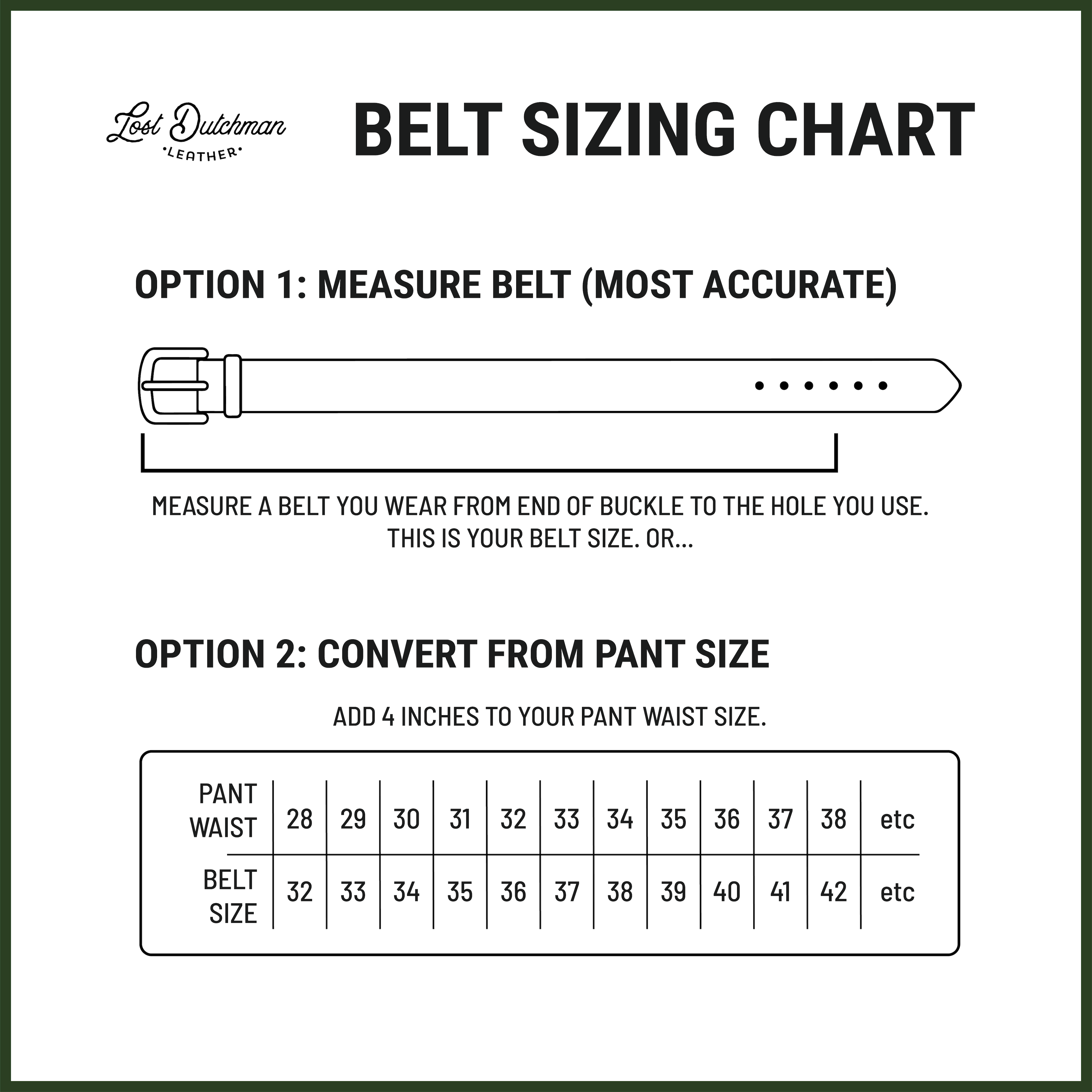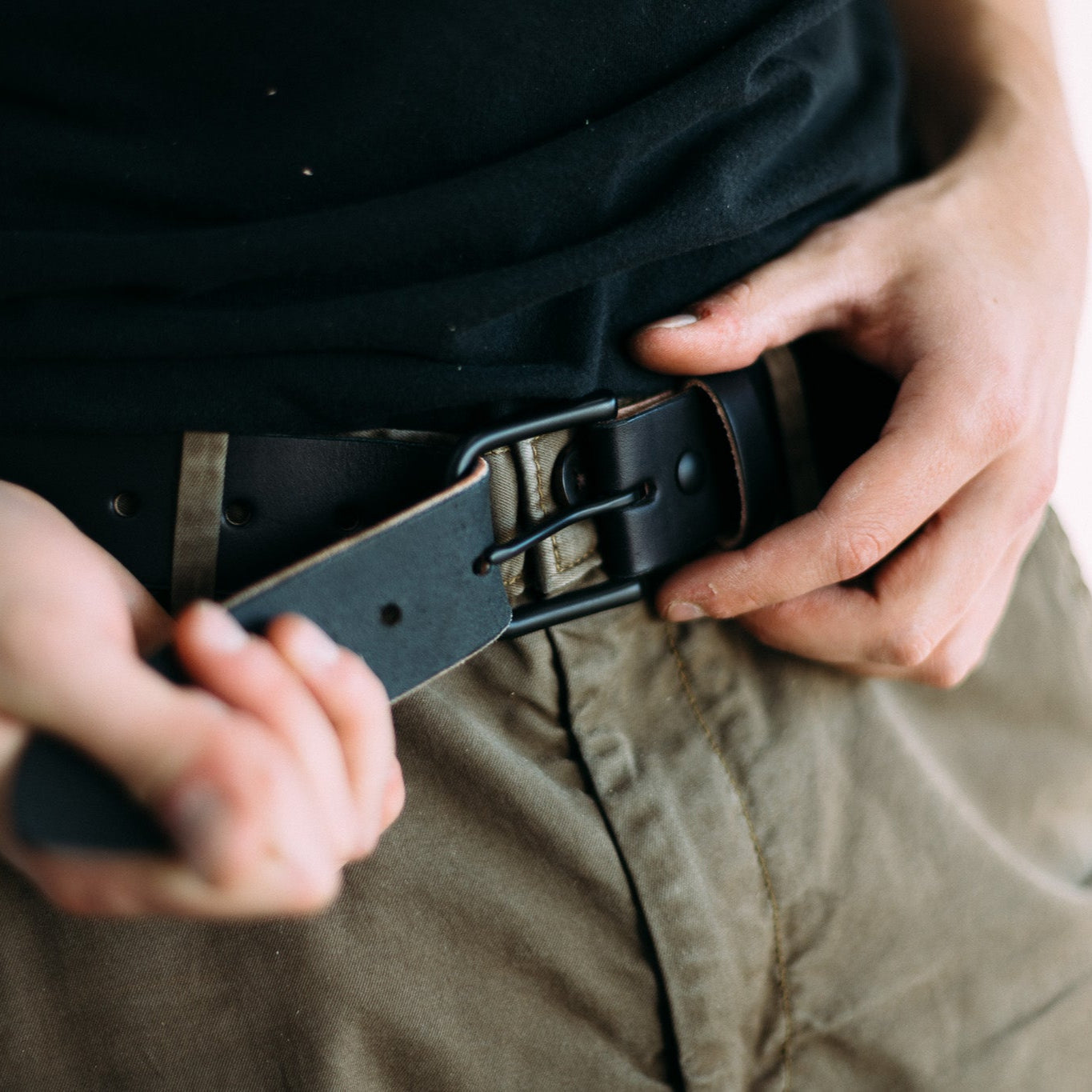
Leather Belt Sizing Guide
Few things are more frustrating than a belt that doesn’t fit. Too long, and the excess tail flaps awkwardly. Too short, and you’re left tugging at a buckle that strains uncomfortably. Finding the right belt size isn’t guesswork; it’s a matter of simple principles. With the right knowledge, you can confidently say, “I know how to find my belt size,” and never face the disappointment of a poor fit again.
This leather belt fit guide is designed to take the guesswork out of the process. It’s about accuracy, comfort, and protecting the integrity of a quality belt so it lasts for decades.
Why Belt Size Matters More Than You Think
A well-fitted belt is subtle. It doesn’t call attention to itself, yet it completes the outfit in ways you might not notice until it’s wrong. A belt that fits perfectly:
-
Closes comfortably on the middle hole.
-
Extends just enough to tuck into the first loop.
-
Moves with you naturally throughout the day.
When the size is off, the problems show immediately. Extra-long belts look sloppy. Too-short belts feel restrictive. Worse, improper sizing damages leather, forcing it to stretch or crack at the holes. A quality belt should age with dignity, developing patina, not deforming under stress.
Think of it like shoes. A well-crafted pair feels invisible on your feet when it fits properly. A bad fit, no matter how beautiful, is a constant reminder of compromise. Belts follow the same truth: comfort and fit are inseparable from style.
Three Reliable Ways to Find Your Belt Size
The most common question customers ask is, “How do I find my belt size?” There are three reliable answers, depending on what tools you have at hand.
1. The Tape Measure Method (Most Accurate)
The most reliable technique uses a tailor’s tape.
-
Put on the pants you wear most often with a belt.
-
Thread the tape measure through the loops.
-
Pull snug, not tight, and read the number in inches.
That number is your true belt size. It accounts for fabric, movement, and comfort.
2. The Trouser Size Shortcut (Quick Reference)
A quick rule of thumb: belt size = trouser size + 4 inches.
So, if your trousers are waist size 34, your belt will usually be size 38.
This works as a starting point, but variations in brands mean it isn’t always exact. That’s why a measuring tape is always the better method.
3. Using an Existing Belt (Trusted Reference)
If you already own a belt that fits perfectly:
-
Lay it flat on a surface.
-
Measure from the buckle’s fold to the hole you use most often.
-
The measurement in inches is your correct belt size.
This method works because it’s based on proven comfort.
Common Mistakes to Avoid
Many sizing frustrations come from small errors. Avoid these pitfalls:
-
Measuring over bulky clothing: Always measure over what you’ll actually wear.
-
Pulling the tape too tightly: Comfort, not restriction, should guide the fit.
-
Trusting trouser size alone: Variations between brands make this unreliable.
-
Ignoring the middle hole rule: A belt should close neatly in the middle, not on the first or last hole.
When You’re Between Sizes
Sometimes, measurements fall between two options. For example, a waist of 35 inches might sit between a 34-inch and 36-inch belt. The rule is simple: always size up.
It’s easier to add an extra hole if necessary than to extend leather that’s too short. Quality belts like The Belt are designed with this flexibility in mind, offering long-lasting comfort across wearers.
How Width and Style Affect Sizing
Belt size isn’t the only detail that matters. Width and style also play a role in fit and appearance.
-
Standard Width (1.5 inches): The most versatile, ideal for jeans and casual trousers.
-
Narrow Width (1.25 inches): Sleek and refined, perfect for suits or chinos. A dressy style pairs beautifully with slim wallets like The Franklin Wallet.
-
Extra Wide (1.75 inches or more): Rugged and bold, often chosen for heavy workwear or vintage-inspired outfits.
When customers search for a leather belt fit guide, they’re not just looking for numbers; they’re looking for how width, buckle, and leather choice complete the outfit.
How Proper Sizing Protects Your Belt
A belt that’s too small is under constant strain, stretching holes and stressing the buckle fold. Over time, the leather cracks where it should have grown richer with patina. Conversely, belts that are too loose bend and sag unnaturally, creating deep creases that age poorly.
By ensuring you find your belt size accurately from the start, you protect both comfort and craftsmanship. A belt sized correctly isn’t just more comfortable, it lasts longer and looks better over time.
An Artisan’s Anecdote
One craftsman once told the story of a customer who insisted on wearing a belt two sizes too small because he liked the “tight” feel. Within a year, the holes had stretched into ovals, the leather cracked, and the buckle fold warped.
The replacement belt, this time sized correctly, looked better five years later than the smaller one had after six months. The lesson? Leather responds to respect. When fitted well, it grows old with grace.
Caring for Your Belt Investment
Once you’ve sized your belt properly, caring for it is just as important.
-
Condition: Apply a leather balm every few months to keep it supple.
-
Clean: Wipe gently with a damp cloth, never soak.
-
Store: Hang vertically or roll loosely; avoid piling belts.
-
Rotate: Alternate between belts to reduce strain.
Accessories like The Catch-All are ideal for storing belts neatly while keeping other essentials within reach.
Completing the Look
The right size does more than feel good; it creates balance. A well-sized belt pairs seamlessly with the rest of your wardrobe.
-
With jeans, The Belt adds rugged durability.
-
With trousers, a slimmer belt pairs with elegant accessories like The Mini Franklin.
-
For everyday carry, match with a wallet from the card holders collection.
This consistency shows care and intention, the marks of refined style.
Closing Note
Sizing a belt doesn’t have to be guesswork. With a simple tape measure, a reliable shortcut, or a trusted belt already in your wardrobe, you can confidently determine the right fit. This leather belt fit guide ensures you never have to wonder, “How do I find my belt size?” again.
Explore the belts collection to discover handcrafted options built for both casual and formal wear. For questions on sizing or custom work, contact us. Our workshop team will help you find a belt that fits as perfectly as it looks.


